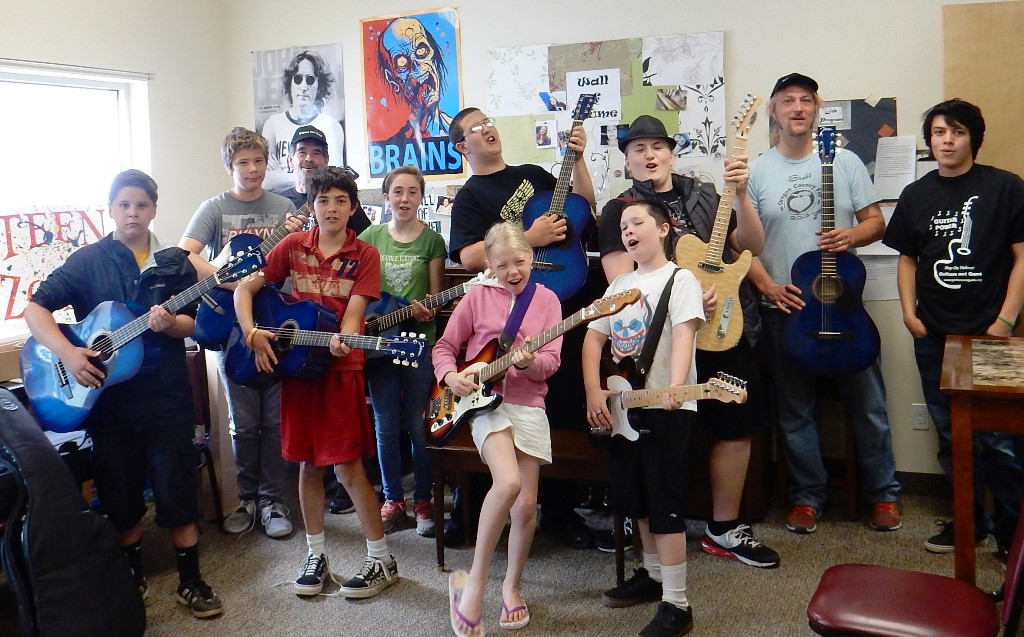Guitars Not Guns, a non-profit organization with chapters in Canada and eleven states in the US, teaches underprivileged children to play the guitar. The organization is anti-gun violence, not anti-gun. By supporting its students in positive social interactions, Guitars Not Guns discourages children from destructive behavior,including gun use, drugs and vandalism.
Nelson’s inspiration for establishing Guitars Not Guns came from his experience as a foster parent. Through the job, he observed the instability present in the lives of many foster children. “Most foster kids move four or five times in high school,” says Nelson. “The one thing they [have] in common [is] that they [carry] around a plastic bag with their clothes in it—that [is] all they [have].”
Believing in the positive impact music can have on a child’s life, Nelson strives to provide foster kids and other underprivileged youth with guitars and lessons. Many disadvantaged children are two to three years behind in school due to trouble focusing. As Nelson explains in an online business newspaper, Georgia Trend, music—which works the right and left sides of the brain—can improve academic performance. “The [children’s] behavior gets calmer, and their self-esteem improves– [it’s] like watching a flower unfold,” he says.
Guitars Not Guns brings music to children ages 8-18 through two levels of eight-week classes. At the end of each session, students are acknowledged at a graduation ceremony where they perform for guardians, law enforcement and other members of the community, receiving certificates of achievement as well as the guitar they have played throughout the program. “[The guitar’s] not free,” explains Gregg Hammond, director of the DC chapter. “It’s a loaned guitar that [the children] have the opportunity to earn.” As long as the students learn to play six guitar chords and can name all of their instrument’s parts by the end of the eight-week session, the guitars are theirs to keep.
“It feels like I’m a rock star,” says graduate Tiahnna Edwards, her dark skin illuminated by a fluorescent orange polo. “I’ve never had a guitar before.”
Edwards’ fellow student agrees: “It’s so fun having a guitar. It’s like a present.”
By the end of the process, some children “feel really empowered” while others “are still trying to find their way,” observes Richard D. Salazar, director of the Santa Cruz chapter. For those struggling with their new skill set, instructors provide encouragement and support. “Even if they learn just one chord,” says Salazar, “that’s one chord more than they knew when they walked in.” Instead of basing a child’s success on their skill level and technique, Guitars Not Guns encourages children “to have fun, be on time, take care of their instrument, socialize with teachers and other students and keep trying.” Through this encouragement, instructors cultivate self-esteem, promote perseverance and instill discipline.
The program also brings students together. “What is really apparent,” comments Salazar, “is that you can take young people from any community and put them in a room and start to talk about music, and [that] breaks all barriers.” The children come from varied backgrounds and carry their own emotional baggage. Music helps them open up, encourages them to communicate and unites them. As Salazar explains, “Music has the power to heal, the power to teach.”
On a SiriusXM radio channel, Jennifer Hammond, sister of the DC chapter director, recounts her experience with Guitars Not Guns. After helping to teach a class, Hammond left in amazement. “To me it was one of the most powerful things to watch,” says Hammond, speaking into the microphone while gesticulating wildly. “There were gang kids and then there were kids that either had physical or mental challenges—they were handicapped in some way. I was amazed [that], even if a child had a twitch or something, as soon as you did the 5-6-7-8 and [they] started trying [to play], all of them became one group…they became a community.”
Elijah, a young Canadian graduate of Guitars Not Guns, reflects on why he joined the program: “I like feeling good,” he remarks in a brief promotional video, gazing into the camera with a smile that crinkles his eyes. “And [because of Guitars Not Guns], when I go home every day, I feel like I’ve accomplished something.” After completing the beginner and intermediate courses, Elijah, like many other graduates, returned as a mentor to help teach a beginning class.
A woman wearing slip-on shoes and a black, cotton dress hands out certificates to twelve children, the last notes of their performance still resonating throughout the crisp evening air. Final words of gratitude are exchanged. Guardians file to their cars while graduates chatter excitedly, admiring the instruments they now call their own. Twelve guitars. Twelve children.

